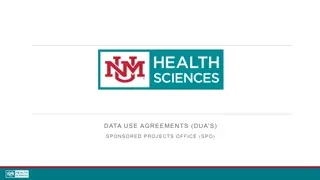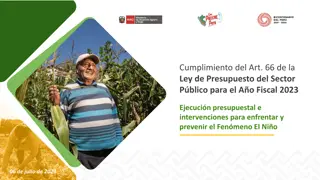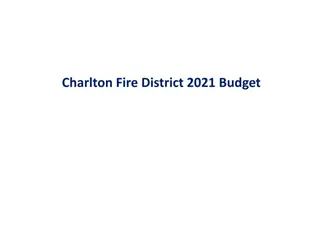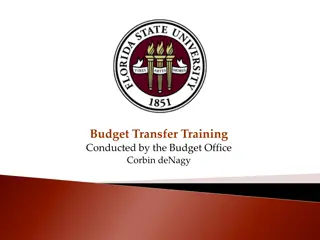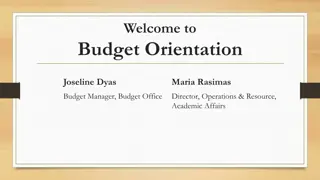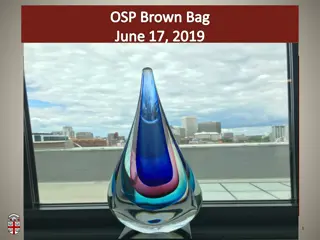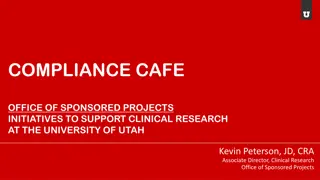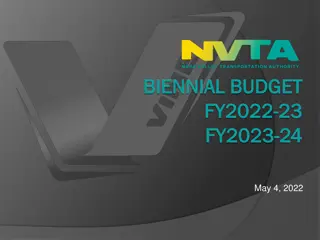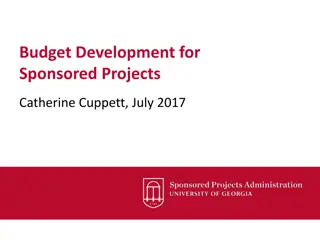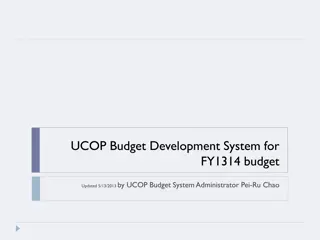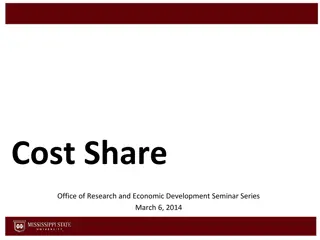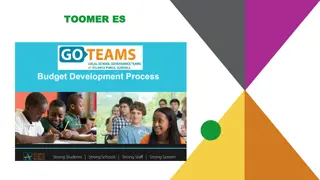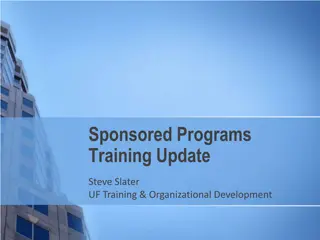Budget Development for Sponsored Projects: Components and Guidelines
In the realm of sponsored projects, understanding the intricacies of budget development is crucial. Learn about key components like RFP/RFA, scope of work, budget justification, direct costs, personnel costs, fringe benefits, indirect costs, and more. Explore the nuances of allocating and justifying expenses to ensure a successful project proposal. Utilize the provided images and explanations to enhance your knowledge and skills in budget development for sponsored projects.
Download Presentation

Please find below an Image/Link to download the presentation.
The content on the website is provided AS IS for your information and personal use only. It may not be sold, licensed, or shared on other websites without obtaining consent from the author.If you encounter any issues during the download, it is possible that the publisher has removed the file from their server.
You are allowed to download the files provided on this website for personal or commercial use, subject to the condition that they are used lawfully. All files are the property of their respective owners.
The content on the website is provided AS IS for your information and personal use only. It may not be sold, licensed, or shared on other websites without obtaining consent from the author.
E N D
Presentation Transcript
Budget Development for Sponsored Projects Catherine Cuppett, Sponsored Projects Administration September 2016
What are the main parts? How do I start? RFP or RFA Scope of Work Budget Budget Justification
Budget Development Direct Costs Allocable Allowable Reasonable Types Salary & Fringe Materials and Supplies Travel Equipment
Direct Costs Personnel Costs Identifiable Working on project Within project period 100% is 100% Rates are set by HR Raises UGA Employees
Direct Costs Fringe Benefits Estimated at time of proposal, but actual rates are charged to the grant. Equipment Items with a useful life of more then 3 years and a cost of $5,000 or more Travel Per diem, airfare, mileage and conference registrations for employees working on sponsored projects in furtherance of the project Supplies Refers to lab/research or programmatic supplies needed to complete a specific scope of work.
Direct Costs Try to think through your project in details. For example if you are using animals ask yourself things like: Do you need a per diem for their care? Where will they be housed? Are there cage costs? Do you need a rack? Will you need special veterinary services to do your project?
Direct Costs Subrecipient or Subcontractor A third-party organization performing a portion of work on a prime UGA or UGARF award. In contrast to a vendor, a subrecipient performs part of the scope of work of the project. Consultant Third part providing highly technical or professional advice. Does not control the manner in which the work is performed. Does not engage in programmatic decision making. Sub vs. Consultant
Indirect Costs Indirect Costs (IDC) or Facilities and Administrative Costs (F&A) Costs that are necessary to support sponsored projects, but are not easy to identify, quantify, and link directly to the scope of work of a project. Pre-Award can help you figure out which rate to use.
Federal Non Federal Research On-Campus (7/1/13 - 6/30/15) 49% 60% Research On-Campus (7/1/15 - 6/30/16) 50% 60% Research Off-Campus 26% 35% Instruction On-Campus 56% 94% Instruction Off-Campus 26% 62% Research Ag. Experimental Station 40% 53% Public Service Agreements On-Campus 37% 50% Public Service Agreements Off-Campus 26% 39% Marine Institute Sapelo Island 35.5% 42% Marine Extension Bruns / Skidaway 46% 55% Cooperative Extension All Locations 30% 38% Research Savannah River Ecology Lab 34% 56% Research Skidaway Island Institute of Oceanography 50% 60%
Where does IDC go? Each fall UGA returns 20% of each sponsored project s reimbursed F&A costs, based on expenditures made in the previous fiscal year. F&A returns are typically made to the budgetary unit managing the award, but can be to other units, depending on the info provided by the PI/co-PI in the eResearch Portal. http://www.policies.uga.edu/FA/nodes/view/809
Other Considerations: Effort Effort the amount of time PI(s), faculty, and other senior personnel spend on a particular activity. Most proposals must show the percentage of effort committed to the project. The percentage of effort should be commensurate with the percentage of salary requested. More than 100% awarded effort is not allowed http://policies.uga.edu/FA/nodes/view/860/Committed-Effort
Other Considerations: Effort Salary savings Each college/center has an incentive plan for ensuring faculty charge effort to projects Funds can be used to cover a variety of costs
Other Considerations: Cost Share Cost Share - refers to that portion of the total project costs not borne by the sponsor. Cash Match - Cash contributions made to a project by UGA, UGARF, or a third party. In-Kind Match - The reasonable value of personnel effort, equipment, materials or other property used in the performance of a statement of work. Third-Party Match - Any expenditure necessary to complete a project that is borne, not by the sponsoring agency or the prime award recipient, but by a third party.
Other Considerations: Cost Share Mandatory The cost share must be included in the proposal budget in order to be considered for funding by the sponsor, as outlined in the RFP. It is a requirement as a condition of the award. Voluntary - The cost share is not required by the sponsor but is offered by the applicant in the proposal. Once cost share is offered, it becomes a binding commitment and must be honored, if the project is funded.
Other Considerations: Cost Share How is cost share tracked? A companion account is set up that is yoked to the restricted account. Anything cost shared (in-kind or cash) has to be moved to the companion account. Cost share obligations must be met. Ideally we like to: Avoid volunteering cost share Use sponsor funds to pay for your effort
Budget Justification A narrative clarification of each of the budget components Explains how dollar amounts were determined Indicates how each item relates to the research plan All items must be justified don t assume their use is obvious to reviewers Explains the who, what, when, where, and why Be sure to explain if meals, visa fees, international travel, and/or incentive payments are critical to the project Listing items is not sufficient for a justification, especially for a CASB exception. A detailed explanation must be included for all requested funds.
Example #1 Partial listing of supplies: gasoline and diesel fuel, insecticides, fungicides, nematicides, sprayer parts too numerous to list, belts, hoses, plow points and other replacement parts which are subject to wear and tear, lime, fertilizer, gypsum, boron, surfactant, paper bags, cloth bags, mesh bags, burlap bags, plastic storage bags, spray paint for marking plants, wire flags for marking plots, plot labels, label holders, ink and ribbon for individual plot labels, hand tools for maintenance and/or harvest such as hoes and pitch forks as needed, tires, batteries, oil and fuel filters for trucks, tractors, and peanut thrashers, printer ink, copier paper, safety equipment, sunscreen, Gatorade, insect repellent, gloves, masks, goggles, notebooks, laminating sheets, binders and binder supplies, pencils, pens, highlighters, markers, rubber bands, paper clips, glue, camera disks for plot photos, batteries, computer CD s and storage devices, folders, notepads, various kinds of tape including transparent, masking, duct, and electrical, lab cleaning supplies, seed trays, paper shredder bags, seed envelopes, reinforcement tabs, divider tabs, staplers, pheromone trap supplies, photo paper, phone pads, coolers to transport samples, rulers, replacement staples, seed tags for bags, sorting and grading supplies such as plastic ware, seed counter trays with sprouts, boxes for seed holding prior to processing, plastic boxes for storage and transportation of seed to off campus sites, boxes for mailing seed samples to collaborators, postage and mailers for correspondence, paper towels and hand cleaner for field and laboratory use, assorted screws, nuts, and bolts as needed, tie-down straps and other items to secure loads for transport to off campus sites, field notebooks and clipboards for data collection, summarization and analysis, post-it notepads, calendars and appointment books for employees, first aid kit supplies, repair kits for sprayers, nozzles, gaskets and o-rings for replacement parts, regulators and fittings for sprayers, PTO pumps and PTO drive shafts for sprayers and peanut digger attachment to tractors, buckets, tubs, and other handling equipment for use with peanut thrashers, felt tip markers including broad tip, fine point and colors for marking bag labels, hull-scrape machine replacement parts and supplies for maturity evaluation, upside down spray can holders for marking plants and plots, aprons, tyvek safety clothing for spraying, planting, and harvesting, and plot signs for field days at off campus sites. This is only a partial listing of individual items and how they may be used, but you get the point, I m sure.
Example #2 Due to the remote off-campus and out-of-state research sites, various laboratory, safety, office supplies, and shipping materials/postage related to packaging, processing, and transporting seeds and samples will need to be purchased.



